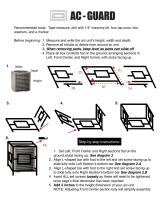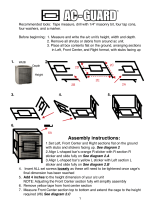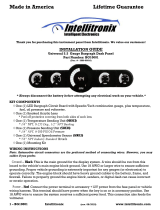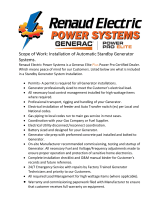
Safety
2 Installation Guidelines for Stationary Diesel Generators
The manufacturer cannot anticipate every possible circumstance that might involve a hazard. The warnings in this
manual, and on tags and decals affixed to the unit, are not all-inclusive. If using a procedure, work method, or operating
technique the manufacturer does not specifically recommend, ensure that it is safe for others. Also make sure the pro-
cedure, work method, or operating technique used does not render the generator unsafe.
• Despite the safe design of this generator, operating this equipment imprudently, neglecting its maintenance, or
being careless can cause possible injury or death. Permit only responsible and capable persons to install, oper-
ate, and maintain this equipment.
• Parts of the generator are rotating and/or hot during operation. Exercise care near running generators.
• If this generator is used to power electrical load circuits normally powered by a utility power source, install a
transfer switch. The transfer switch must effectively isolate the electrical system from the utility distribution sys-
tem when the generator is operating. Failure to isolate an electrical system by such means will result in damage
to the generator and also may result in injury or death to utility power workers due to backfeed of electrical
energy.
Generators produce potentially lethal voltages. Ensure all steps are taken to make the genera-
tor safe before operation or service.
1.3 — General Hazards
• For safety reasons, the manufacturer recommends that this equipment be installed, serviced, and repaired by an
Authorized Service Dealer or other competent, qualified electrician or installation technician who is familiar with
all applicable codes, standards, and regulations.
• Ensure that the generator is installed, operated, and serviced in accordance with the manufacturer’s instructions
and recommendations. Following installation, do nothing that might render the unit unsafe or in noncompliance.
• The engine exhaust fumes contain carbon monoxide, which can be DEADLY. If breathed in sufficient concentra-
tions, carbon monoxide can cause unconsciousness or even death. For this reason, adequate ventilation must
be provided. Exhaust gases must be piped safely away from any building or enclosure that houses the generator
to an area where people, animals, etc. will not be harmed.
• Keep hands, feet, clothing, etc. away from drive belts, fans, and other moving or hot parts. Never remove any
drive belt or fan guard while the unit is operating. Ensure that all guards, covers, and protective devices removed
during maintenance or service are reinstalled.
• Adequate, unobstructed flow of cooling and ventilating air is critical to prevent buildup of explosive gases and to
ensure correct generator operation. Do not alter the installation or permit even partial blockage of ventilation pro-
visions, as this can affect safe operation of the generator.
• Keep the area around the generator clean and uncluttered. Remove any materials that could become hazardous.
• When working on this equipment, remain alert at all times. Never work on the equipment when physically or men-
tally fatigued.
• Inspect the generator regularly, and promptly repair or replace any worn or damaged components using only fac-
tory approved parts and procedures.
• Before performing any maintenance on the generator, always disconnect the battery cables to prevent accidental
startup. Disconnect the cable from the battery post indicated by a NEGATIVE, NEG, or (–) first, then remove the
POSITIVE, POS, or (+) cable. When reconnecting the cables, connect the POSITIVE cable first, the NEGATIVE
cable last.
• Never use the generator or any of its parts as a step. Stepping on the unit can stress and break parts, and may
result in exhaust, fuel, oil or coolant leaks.























